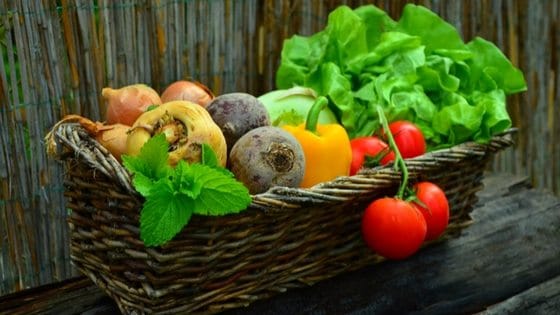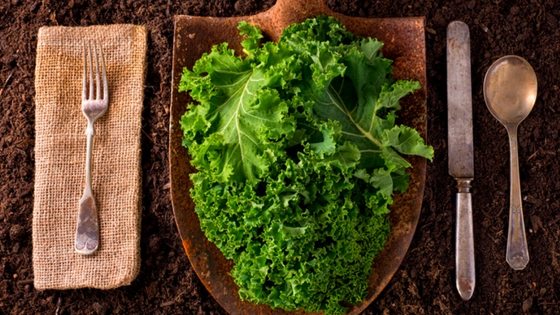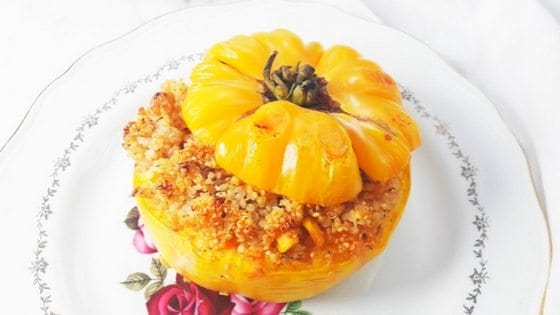Are you looking for some excellent companion planting container gardening ideas?
You’ve come to the right place.
There are plenty of ideas out there when it comes to companion planting in a regular garden. You’ve likely heard of the Three Sisters, the infamous planting of corn, beans, and squash that is designed to maximize yields and minimize pests.
However, when it comes to container gardening ideas – a must-have for urban gardeners – all you’ll hear is crickets.
That’s not to say that companion planting doesn’t work well in a container garden, however. In fact, we’ll walk you through some of the best companion planting container gardening ideas out there so you can improve your yields and minimize the amount of work it takes for you to care for your garden.
Table of Contents (Quickly Jump To Information)
What is Companion Planting?
Companion planting is a method of growing fruits, vegetables, flowers, and herbs so that you can harness the benefits of all the plants in your grouping.
By planting certain species together that are known to offer certain benefits, you can reduce the amount of time you have to spend weeding, watering, fertilizing, and otherwise caring for your plants.
For example, some plants have pest-repellent properties that can help keep certain types of bugs away from vulnerable plants. Others fix certain nutrients into the soil (beans are a good example), helping to improve the availability of these necessary components for your other plants.
Companion planting is a smart way to make the most of the space you have – and it’s a technique that can be incorporated into any garden.
Best Companion Planting Container Gardening Ideas
Container Salad Mix
One of the most common companion planting container gardening ideas is that of salad vegetables. This is not only convenient for you as you are preparing a salad for dinner, but is also highly beneficial for the plants.
Start by planting a large tomato plant in the center of a container but about five inches from the back so it won’t shade tinier plants. Around the tomato, you can place a mixture of lettuce, spinach, and even carrot seeds.
If you have extra room left over and want to increase your protection against insects, you can plant a sage plant or some rosemary, both of which will provide a lovely garnish for your salad.
Lettuce and Root Crops
Growing lettuce with root crops is a smart choice because lettuce grows rapidly and can be harvested before your root vegetables reach full maturity. The lettuce will help to prevent weeds and will provide necessary shade to your cold-loving root vegetables. It will also help retain soil moisture.
You might consider planting lettuce with turnips, carrots, beets, or onions. To do this, plant the root crops at the distance specified on the seed packets, then plant the lettuce seeds between the rows.
Container Herb Garden
There are all kinds of herbs that can be grown together, which is why many people dedicate entire sections of their gardens exclusively to herbs.
The real beauty of growing herbs is that they take up very little space yet offer high yields for their small size. Most are drought-tolerant, too, and remarkably easy to care for.
You can grow all kinds of herbs together in a container since they are so small, but here are a few groupings you might want to consider:
- Stevia, lemon mint, lemon balm, lemon basil
- Rosemary, sage, thyme, bay laurel
- Cilantro, thyme, oregano, mint, parsley
- Lemon verbena, rose geranium, anise hyssop
The only cautionary advice here is that you will want to keep an eye on your mint as it grows – it has a tendency to sprawl and can be somewhat invasive.
Pizza Garden
Love pizza? You can easily grow your own DIY pizza garden in a container! Plant the following herbs together: oregano, basil, and chives. Add a determinate variety of bush tomato, and you’ll have everything you need for a delicious one-stop pizza shop.
There are other benefits (besides convenience while cooking!) to planting these species together, too. Basil has pest-repelling properties that help keep certain bugs off your tomatoes- you’ll appreciate this in the dead of summer when all of your other tomatoes are falling victim to pests like aphids, hornworms, and milkweed bugs. Basil is also a natural fungicide!
Container Gardening Ideas for Tomatoes
As you may have already noticed by reading the other tips in this article, tomatoes are perfect for container plants if you’re looking for ideal companion planting container gardening ideas. Not only do they grow well in containers, but they benefit from a long list of other plants, too.
Here are some plants you can grow in containers with tomatoes:
- Cucumbers (with climbing support – it won’t shade out the tomato when planted correctly)
- Parsley
- Nasturtiums and marigolds (the flower draw insects away)
- Onions or chives
- Carrots
The “Two” Sisters
You’ve already heard of the classic “Three Sisters” planting, but it’s best to ditch one sister if you’re growing in a container. Corn does not grow well in a container, not only because it needs a lot of space, but also because it needs to be wind-pollinated and planted near other corn plants.
You can easily plant squash and beans in a container, however. They can be grown in vining or bush form, but the best way to do this is to plant one of both. That way, you can string up one crop vertically and keep the other low so it can shade the soil.
Any kind of squash will do, but summer squash (like zucchini) will usually work best. You can also throw a few marigolds or nasturtiums in the container to keep pests away.
Pickles Pot
Love homemade pickles? Why not grow a few pickling cucumber plants with dill and other pickling spices, like fennel, garlic, or coriander? All of these grow well together and are easy to maintain in a container, as long as you provide a trellis for your cucumbers to crawl up as they mature.
Companion Plantings to Avoid
You can plant just about any kinds of plants together, but there are a few combinations you will want to avoid.
Some plants have allelopathic properties, which means they release compounds and chemicals around them that are meant specifically to kill surrounding plants. In the wild, the goal of these properties would be to eliminate competition from weeds and other neighboring plants. However, when you’re growing plants in containers, that’s something you really don’t want to have to deal with.
Other plants simply don’t play well with others because they have similar nutritional needs and can overcrowd a small space very easily. Some attract the same types of pests, meaning you’ll be doubling your risk of infestation by planting the two together.
Avoid planting these combinations in containers:
- Carrots with dill
- Beans with garlic
- Onions with beans
- Fennel with carrots
- Tomatoes with potatoes
- Potatoes with squash
- Onions with peas
How to Get Started with Gardening in Containers
Getting started with planting companion species in containers is easy.
For starters, you are going to want to select the largest possible container. Small Containers not only dry out more quickly, but will easily become overcrowded if you are growing multiple types of plants.
If you grow any kind of root crop, you’ll want a super deep container so that it can support the lengthy roots. The deeper the container, the better, because it usually requires less watering, too.
Look into the specific lighting requirements of your plants, but remember that most vegetables require at least six hours of sunlight. Some leafy greens and most herbs, however, can get by with less. When you’re planting vegetables, fruits, and herbs of varying heights, remember that some of that allows plants to easily overshade the shorter ones, so account for this in your container placement, too.
If you’re growing any kind of crawling or vining plant, be sure to install a trellis. This should be done before you plant to avoid damaging the fragile, developing seedlings.
Choose a potting soil that is designed specifically for container plants. Don’t use soil from your garden, as it can be contaminated with pathogens that will harm your new plantings.
Reasons to Utilize Companion Planting in Containers
Container gardening is a quick, easy way to save space while growing a ton of fresh vegetables, herbs, and fruits right on your doorstep. Not only will growing vegetables in containers help reduce your overall weeding and pest control chores, but it also takes up much less space and time than if you were to grow plants in a regular garden.
The easiest way to utilize all the benefits of containers is to strategically place plants so that they complement and benefit each other. Companion planting in containers can not only reduce the rate of pest infestations and diseases, but it can also improve your overall yields.
With so many potential combinations to try, why not give osm of these companion planting container gardening ideas a try today?
Maat van Uitert is a backyard chicken and sustainable living expert. She is also the author of Chickens: Naturally Raising A Sustainable Flock, which was a best seller in it’s Amazon category. Maat has been featured on NBC, CBS, AOL Finance, Community Chickens, the Huffington Post, Chickens magazine, Backyard Poultry, and Countryside Magazine. She lives on her farm in Southeast Missouri with her husband, two children, and about a million chickens and ducks. You can follow Maat on Facebook here and Instagram here.

![6 Steps to Start Hunting Today [1 Year Of Meat On 2 Acres (Or Less ) Series]](https://thefrugalchicken.com/wp-content/uploads/2016/02/start-hunting-today-feature-min.jpg)


![Substitute Honey For Sugar & Get Perfect Baked Goods [Conversion Chart]](https://thefrugalchicken.com/wp-content/uploads/2017/06/Can-I-substitute-honey-for-sugar-feature.jpg)

